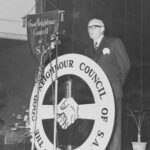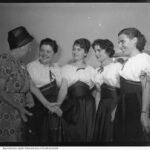At a public meeting in July 1949 chaired by Premier Tom Playford, the South Australian Council of Social Service formed the Good Neighbour Council to assist newly arrived British and European migrants. A State Council coordinated the volunteer networks of ‘good neighbours’ as they spread across suburbs and country towns, linking them with other service organisations and the media. In January 1950 the movement became national. Recognising the value of the organisation in promoting positive community attitudes towards ‘New Australians’, the Commonwealth Department of Immigration then subsidised the council’s administrative costs.
Goals of the Good Neighbour Council
The Good Neighbour Council reflected the assimilationist attitudes of the 1950s and 1960s, when immigrants were expected to blend into Australian society. On visits to migrant hostels and at social functions, volunteers acquainted the new settlers with Australian laws, customs, history, citizenship, local facilities, housing and employment, and helped with English lessons.
Multiculturalism and the Decline of the Council
The council’s decline in the late 1970s reflected the trend towards multiculturalism. With newcomers arriving from many countries, state and federal governments reviewed assistance given to non-English-speaking settlers, employing trained teachers, interpreters and social workers in specialised programs and supporting multicultural councils and migrant resource centres. Funding for Good Neighbour Councils was curtailed, and although some branches continued with the aid of public donations, all South Australian operations ceased in 1989.






Comments
2 responses to “Good Neighbour Council”
My Mum Mrs Gloria Gottschalk (her married name) worked for the SA Good Neighbour Council in the 60’s.
That’s fantastic Annette, it must have been an interesting experience for her.